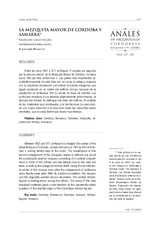La Mezquita Mayor de Córdoba y Samarra

Ver/
Autor
Giese-Vögeli, Francine
Editor
Universidad de Córdoba, Área de ArqueologíaFecha
2008Materia
Córdoba (España)Damasco
Samarra
Mezquita
Fachada del mihrab
Mosaicos
Damascus
Mosque
Mihrab façade
Mosaics
METS:
Mostrar el registro METSPREMIS:
Mostrar el registro PREMISMetadatos
Mostrar el registro completo del ítemResumen
Entre los años 962 y 971 al-Hakam II amplía por segunda vez la sala de oración de la Mezquita Mayor de Córdoba, fundada hacia 785 por Abd al-Rahman I. Las partes más importantes arquitectónicamente de esta fase son sin duda la antigua maqsura con su riquísima decoración y el mihrab de planta octogonal, que siguió quedando en el centro del edificio incluso después de la ampliación de al-Mansur. Por su zócalo de losas de mármol, sus suntuosos mosaicos y sus yeserías originalmente policromadas, la fachada del mihrab se distingue del resto del edificio. El análisis de los materiales aquí empleados y de las técnicas de ejecución, da una nueva dirección a la discusión sobre las presuntas raíces orientales, que se creía terminada desde hace tiempo. Between 962 and 971 al-Hakam II enlarged the oratory of the Great Mosque of Cordoba, constructed around 785 by Abd al-Rahman I, adding twelve bays to the south. The masterpiece of this second enlargement of the Umayyad oratory is without any doubt the sumptuosly adorned maqsura consisting of a central compartment in front of the mihrab and two lateral ones to the east and west, as well as the octogonal mihrab itself, being the architectural center of the mosque even after the enlargement of al-Mansur some twenty years later. With its marble incrustation, the mosaics und the originally painted stucco decoration, the central mihrabfaçade is distinguished among the others. The study of the here employed materials gives a new direction to the apparently solved question of the oriental origin of the Cordobese mihrab-façade.
